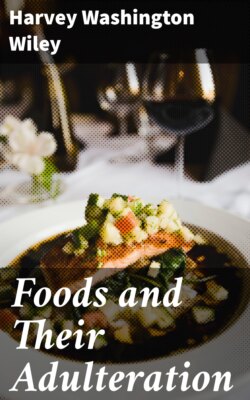Читать книгу Foods and Their Adulteration - Harvey Washington Wiley - Страница 110
На сайте Литреса книга снята с продажи.
Bechi or Silver Nitrate Test for Cottonseed Oil.
Оглавление—Reagent: Dissolve 2 grams of silver nitrate in 200 cubic centimeters of 95 percent alcohol and 40 cubic centimeters of ether, adding one drop of nitric acid.
Mix 10 c.c. of oil or melted fat, 5 c.c. of reagent, and 10 c.c. of amyl alcohol in a test tube. Divide, heat one-half in a boiling water bath for ten minutes, and then compare with portion not heated. Any blackening due to reduced silver shows presence of cottonseed oil.
Other oils which have become rancid, and lards which have been steamed or heated at high temperature, contain decomposition products which have a reducing action on silver nitrate. There were found in testing a large number of salad oils some which contained no cottonseed oil, according to the Halphen test, but gave a brown coloration with Bechi reagent, and in some cases reduced silver. These same oils on being purified gave no reaction. Hence the oils or fats should be purified before testing.
To purify the oils and fats, heat from 20 to 30 grams on water bath for a few minutes with the addition of 25 c.c. of 95 percent alcohol, shake thoroughly, decant as much of the alcohol as possible, and wash with two percent nitric acid, and finally with water. The oil or lard thus purified will give no reduction at all if it contains no cottonseed oil. Heating the oils or fats to 100° C. or simple washing with two percent nitric acid is not sufficient, except in a few cases.
With oils the use of the Halphen and Bechi tests will be found to be useful as a means of approximately determining the amounts of adulteration present. If Halphen gives a reaction and Bechi does not, the adulteration with cottonseed oil is probably less than 10 percent.
The admixture of beef fat with lard is best detected by means of the microscope. The fat is dissolved in ether and allowed to slowly crystallize. If it is composed of pure lard the crystal assumes a form which is represented in Fig. 8.
If, on the other hand, beef fat be mixed with lard, the crystals will assume a radiated fan-shaped appearance shown in Fig. 9. Even one who is an expert with the microscope may not be able without some difficulty to detect these adulterations by the simple tests above mentioned.
Fig. 8.—Lard Crystals. × 140.—(Bureau of Chemistry.)
Fig. 9.—Beef Fat Crystals. × 140.—(Bureau of Chemistry.)
